
Seoul Subway Line 1 of the Seoul Metropolitan Subway is a rapid transit and commuter rail line which links central Seoul, South Korea to Yeoncheon in the northeast, Incheon in the southwest, and Sinchang via Suwon and Cheonan in the south. The central underground portion of Line 1, running underneath Sejongno, Jongno, and Wangsan-ro avenues along Seoul's traditional downtown area, is the oldest subway-operated section in the Seoul Metropolitan Subway system. Its branches and services cover a large part of the Seoul Metropolitan Area; totaling 218.3 km (135.6 mi) in route length.

Anguk station, also known as Hyundai E & C station (Korean: 현대건설), is a subway station on the Line 3 of the Seoul Metropolitan Subway. The station is located in the Anguk neighborhood of Jongno District, Seoul and is the nearest subway station to the Insa and Samcheong neighborhoods. The station is also near the ancient royal residence of Unhyeongung.
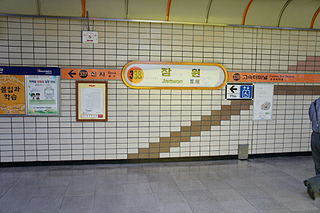
Jamwon Station (Korean: 잠원역) is a station on the Seoul Subway Line 3. It is located in Jamwon-dong, Seocho District, Seoul.

Apgujeong is a rapid transit station on Seoul Subway Line 3. It is located in Apgujeong-dong, Gangnam District, Seoul. It has a pair of underground side platforms. The station has connections to 15 buses through 6 exits. It services Sinsa-dong and Apgujeong-dong. The area is named after a pavilion frequented by Han Myung-hoi, whose pen-name was Apgujeong, and its sub-name comes from the nearby flagship Apgujeong Main store of Hyundai Department Store.

Seoul National University Station is a station on Seoul Subway Line 2, located in Bongcheon-dong, Gwanak-gu of southern Seoul. This station is also known as Gwanak-gu Office Station. There are eight exits, two at each corner of the crossroads – of Nambu Beltway (Nambusunhwan-ro) and Gwanak-ro – where the station lies beneath.

Kkachisan Station (pronunciation as Katsisam) is a station on Seoul Subway Line 5, as well as the northwestern terminus of the Sinjeong Branch of Line 2. Seoul Metro operates both Line 2 and 5 platforms.
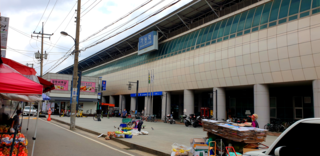
Ganeung station is a metro station on the Line 1 of the Seoul Metropolitan Subway. The station is located in northern Uijeongbu and previously served as the northern terminus for Line 1 before its extension to Soyosan.
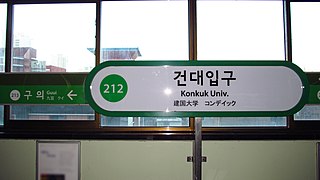
Konkuk University Station is a rapid transit station on Seoul Subway Line 2 and Seoul Subway Line 7. It is located in Hwayang-dong in the Gwangjin-gu administrative district of Seoul. It is adjacent to Konkuk University from which it takes its name. Line 2 is serviced by an elevated platform while Line 7 is serviced by an underground platform. The station has connections to ten bus lines through its six exits as well as a connection to the airport shuttle bus. The station services Hwayang-dong as well as Jayang-dong and Noyu-dong. The area around the station is mixed residential and small commercial businesses. Exits from the underground Line 7 platform open into Konkuk University and the adjacent Star City shopping and high-rise residential tower complex.

Chang-dong Station is a station on Seoul Subway Line 1 and Line 4. It is located in Chang-dong, Dobong District, Seoul, South Korea. A shopping center was planned for this site, but the empty lot has never been developed due to the bankruptcy of the contractor behind said project. The station is, however, home to a cluster of pojangmacha stalls.

Seongsu Station is a rapid transit station on Seoul Subway Line 2. It is located in Seongsu-dong in the Seongdong-gu administrative district of Seoul. It is also the southeastern terminus of Line 2's Seongsu Branch to Sinseol-dong. Trains needing to be serviced take the Seongsu Branch from this station and go to the Gunja Train Depot behind Yongdap Station.

Jihaeng station is a ground-level metro station on Line 1 of the Seoul Subway in Jihaeng-dong, Dongducheon, South Korea. It opened on January 30, 2005, to services on the Gyeongwon Line and services on the Seoul Metropolitan Subway began calling here on December 15, 2006. The station offers access to Dongducheon Foreign Language High School, Central Middle and High School, Jihaeng Elementary School, Science Tower and Songnae-dong Office, among other places.
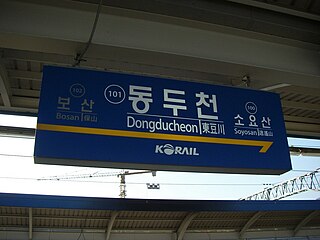
Dongducheon Station is a metro station located in Dongducheon, South Korea. Seoul Subway Line 1 serves this station, and it is the terminus station for Gyeongwon Line express trains. Camp Casey, a U.S. Army military base, is located nearby.

Bosan station is a subway station located at Dongducheon, Gyeonggi Province, South Korea. This station is on the Seoul Subway Line 1. Camp Casey, an American military base, is located nearby.

Gyeongbokgung station (Korean: 경복궁역) is a subway station on Line 3 of the Seoul Metropolitan Subway. It is the subway station nearest to the Gyeongbokgung Palace. The station is also near the Government Complex–Seoul, the National Police Agency of South Korea, and other administrative buildings in the neighborhood.

Dongducheon Jungang Station (Korean: 동두천중앙역) is a train station on the Seoul Subway Line 1 and the Gyeongwon Line. The name means Dongducheon Central Station. It was also once known as Eosu-dong Station.
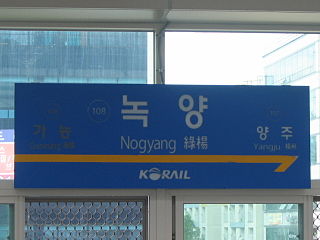
Nogyang Station is a station on the Gyeongwon Line in South Korea. It is served by Seoul Subway Line 1. The station lies in the far northern end of Uijeongbu in Gyeonggi-do.

Yangju Station is a train station on Seoul Subway Line 1 and the Gyeongwon Line. The name comes from Yangju, the city where this station is located. Until December 2007, it was called Junae Station.

Deokgye station is a train station on Line 1 of the Seoul Subway. It opened in December 2007.

Juan station is a subway station on the Seoul Metropolitan Subway Line 1 and Incheon Subway Line 2. This station receives the second-highest number of crowds along the entire Incheon line due to its proximity to the downtown area. It is also near Inha University and Inha Technical College.
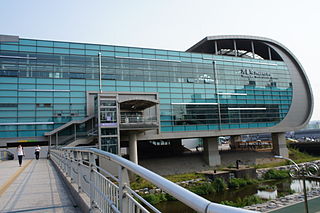
Giheung Station is a subway station of the Suin–Bundang Line and the EverLine, in the city of Yongin, Gyeonggi Province.





















